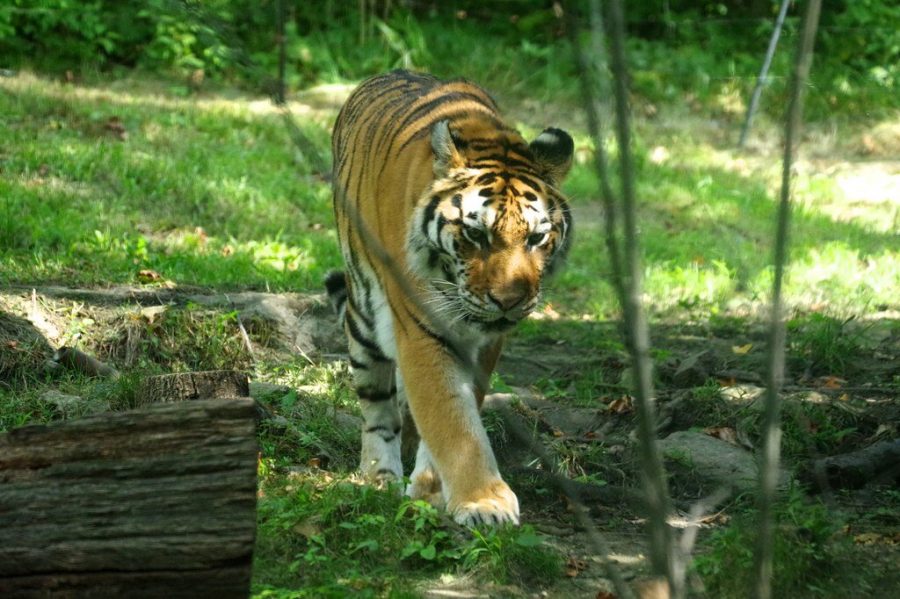Bronx Zoo Tiger testing positive for COVID-19 raises health concerns for animals
April 18, 2020
Nadia had been exhibiting signs such as an inability to finish her meals and a dry cough. Her condition brought concern from her caretakers, resulting in the zoo running tests on her. Three other labs at Cornell University, the University of Illinois, and the National Veterinary Services Laboratory confirmed a positive test result.
By the time the discovery of her contraction was made, six other tigers were found to be infected, as the coronavirus is considered to be zoonotic. This means that a disease or illness can be spread from an animal to a human. Hence, the Bronx Zoo believes that one of the zoo staff members could have been infected unknowingly and spread it to Nadia.
Though an investigation looking into how Nadia could have been exposed to the virus is ongoing, “ Public health officials believe these large cats became sick after being exposed to a zoo employee who was actively shedding virus,” according to the Center for Disease Control.
Caretakers at the zoo will now be maintaining social distancing practices with the cats in the zoo, in an effort to prevent further spreading. The infected cats are being treated and are improving in health.
Evidently, cats are susceptible to the coronavirus. Zoo staff worry that other animals may be as well, such as gorillas which are closely related to humans. This begs the question as to which animals are affected by coronavirus and which are not.
Scientists are aware that animals like cats, dogs, pigs, and bats are able to get influenza, or the common flu that impacts millions of humans every year. They do not know, however, how this knowledge translates to coronavirus being able to affect animals, but it is a reason to consider possible spread from human to animal contact.
Among the animals known to have tested positive worldwide, there are two dogs in Hong Kong, one cat from Belgium, and the six tigers from the Bronx Zoo. All of these animals had contact with humans, whether it be feeding time at the zoo or going on a walk with an owner, who could have spread the virus.
In fact, the infected dog that had died in Hong Kong was residing with his owner that had also tested positive. Though the owner refused to have an autopsy carried out, some believe that the owner may have shared the disease with the dog.
The science community is unable to agree on what animal for certain can get the coronavirus. In one study, it was found that cats are definitely vulnerable, while dogs are not. In fact, it reported the virus was spread “via respiratory droplets” and that “Infected cats had virus in the mouth, nose and small intestine. Kittens exposed to the virus had massive lesions in their lungs, nose and throat.” according to Reuters. Though this study answers the question of how the disease is spreading, it is then negated by the two cases of dogs in Hong Kong.
Another important fact is that there is no concrete evidence a person can spread the coronavirus to an animal. “University of Nottingham associate professor of veterinary virology Dr Rachael Tarlinton says: “This is theoretically possible, the same as for any other surface, like a person’s hands or clothing, but we haven’t actually seen this happen in any cases so far,” according to BBC News.
Though there is not clear evidence that pets are possible hosts for the virus, The World Health Organization has taken the firm stance that as of now, owners cannot pass the virus to their pets. Still, experts advise pet owners to not have excessive contact with them, which includes not petting, kissing or hugging pets. Though difficult to ask of a pet owner, these measures are necessary in preventing the spread of the coronavirus to the animal or owner.
The discovery of Nadia’s case is instrumental as it could be indicative of a potential outbreak among animals worldwide. In fact, this is reminiscent of the West Nile virus epidemic, according to Professor Tracey McNamara of Western University of Health Sciences College of Veterinary Medicine details.
“In the summer of 1999, McNamara was the Bronx Zoo’s chief pathologist when she noticed neurologically-damaged crows dropping into exhibits at the zoo. McNamara soon realized that the virus killing crows — and a pair of captive-bred Chilean flamingos at the zoo — was likely the same mysterious form of encephalitis hospitalizing New Yorkers at the time. What was eventually identified as West Nile virus spread to animals throughout the zoo, including a cormorant, an Asian pheasant, rhinoceroses, snow leopards, and elephants,” according to New York Magazine.
Hence, the immediate and rapid spread of the coronavirus to the other tigers at the Bronx Zoo is not something to be taken lightly. The Bronx Zoo’s cases could be the calm before a possibly deadly storm on a global level. Scientists need to determine how the coronavirus spreads to animals and which ones. The longer this information remains unknown, the more the health of not just humans but animals worldwide, is jeopardized.








